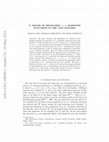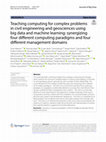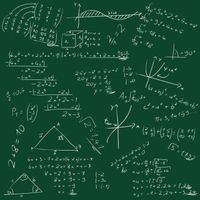Papers by Miodrag Mateljevic
Ukraïnsʹkij matematičnij vìsnik, Jan 30, 2023
We study the mappings of the Orlicz--Sobolev classes with a branching defined in the unit ball of... more We study the mappings of the Orlicz--Sobolev classes with a branching defined in the unit ball of the Euclidean space. We have obtained estimates for the distortion of the distance under these mappings at the points of the unit sphere. Under some conditions, we have also obtained the Hölder continuity of the mappings mentioned above. If we suppose that the considered mappings are solutions to certain Laplacian-gradient inequalities, we get the Lipschitz property. In section 7-9, we review some results, prove a new result, Theorem 7.1, and outline the proof of Theorem 9.2.
Proceedings of the Edinburgh Mathematical Society, Jun 15, 2023
Assume that f is a real ρ-harmonic function of the unit disk $\mathbb{D}$ onto the interval $(-1,... more Assume that f is a real ρ-harmonic function of the unit disk $\mathbb{D}$ onto the interval $(-1,1)$, where $\rho(u,v)=R(u)$ is a metric defined in the infinite strip $(-1,1)\times \mathbb{R}$. Then we prove that $|\nabla f(z)|(1-|z|^2)\le \frac{4}{\pi}(1-f(z)^2)$ for all $z\in\mathbb{D}$, provided that ρ has a non-negative Gaussian curvature. This extends several results in the field and answers to a conjecture proposed by the first author in 2014. Such an inequality is not true for negatively curved metrics.

arXiv (Cornell University), May 18, 2023
We prove existence and uniqueness of a solution of the Dirichlet problem for separately (α, β)-ha... more We prove existence and uniqueness of a solution of the Dirichlet problem for separately (α, β)-harmonic functions on the unit polydisc D n with boundary data in C(T n) using (α, β)-Poisson kernel P α,β (z, ζ). A characterization by hypergeometric functions of separately (α, β)-harmonic functions which are also m-homogeneous is given, this characterization is used to obtain series expansion of separately (α, β)-harmonic functions. Basic H p theory of such functions is developed: integral representations by measures and L p functions on T n , norm and weak * convergence at the distinguished boundary T n. Weak (1, 1)-type estimate for a restricted non-tangential maximal function M NT A,B is derived. Slice functions u(z1,. .. , z k , ζ k+1 ,. .. , ζn), where some of the variables are fixed, are shown to belong in the appropriate space of separately (α ′ , β ′)-harmonic functions of k variables. We prove a Fatou type theorem on a. e. existence of restricted non-tangential limits for these functions and a corresponding result for unrestricted limit at a point in T n. Our results extend earlier results for (α, β)-harmonic functions in the disc and for n-harmonic functions in D n .
arXiv (Cornell University), May 8, 2018
Springer eBooks, 1980
ABSTRACT
Kragujevac journal of mathematics, 2003
ABSTRACT For basic properties of harmonic maps and for further information on the literature we r... more ABSTRACT For basic properties of harmonic maps and for further information on the literature we refer to [Jo] and Schoen-Yau [SYa3].

Journal of Big Data, May 31, 2023
This article describes a teaching strategy that synergizes computing and management, aimed at the... more This article describes a teaching strategy that synergizes computing and management, aimed at the running of complex projects in industry and academia, in the areas of civil engineering, physics, geosciences, and a number of other related fields. The course derived from this strategy includes four parts: (a) Computing with a selected set of modern paradigms-the stress is on Control Flow and Data Flow computing paradigms, but paradigms conditionally referred to as Energy Flow and Diffusion Flow are also covered; (b) Project management that is holistic-the stress is on the wide plethora of issues spanning from the preparation of project proposals, all the way to incorporation activities to follow after the completion of a successful project; (c) Examples from past research and development experiences-the stress is on experiences of leading experts from academia and industry; (d) Student projects that stimulate creativity-the stress is on methods that educators could use to induce and accelerate the creativity of students in general. Finally, the article ends with selected pearls of wisdom that could be treated as suggestions for further elaboration.
arXiv (Cornell University), Aug 20, 2018
We give simple proofs of various versions of the Schwarz lemma for real valued harmonic functions... more We give simple proofs of various versions of the Schwarz lemma for real valued harmonic functions and for holomorphic (more generally harmonic quasiregular, shortly HQR) mappings with the strip codomain. Along the way using the principle of subordination and the corresponding conformal mapping, depicted on the Figure 1, we get a simple proof of a new version of the Schwarz lemma for real valued harmonic functions (see Theorems 4 and 5) and Theorem 6 related to holomorphic mappings. Using the Schwarz-Pick lemma related to distortion for harmonic mappings and the elementary properties of the hyperbolic geometry of the strip we prove Lemma 4, which is a key ingredient in the proof of Theorem 7 which yields optimal estimates for modulus of HQR mappings.
Springer proceedings in mathematics & statistics, 2021
arXiv (Cornell University), May 17, 2023
Assume that f is a real ρ-harmonic function of the unit disk D onto the interval (−1, 1), where ρ... more Assume that f is a real ρ-harmonic function of the unit disk D onto the interval (−1, 1), where ρ(u, v) = R(u) is a metric defined in the infinite strip (−1, 1) × R. Then we prove that |∇f (z)|(1 − |z| 2) ≤ 4 π (1 − f (z) 2) for all z ∈ D, provided that ρ has a non-negative Gaussian curvature. This extends several results in the field and answers to a conjecture proposed by the first author in 2014. Such an inequality is not true for negatively curved metrics. CONTENTS 4 2. Proof of main results 6 2.1. Proof of Theorem 1.5 9 3. Concluding remarks 12 Competing interests 13 Acknowledgments 13 References 13 2000 Mathematics Subject Classification. Primary 30F15 .
Georgian Mathematical Journal, Aug 30, 2022
We prove the Hölder continuity of a homeomorphism f defined on a bounded domain Ω ⊂ ℝ n {\Omega\s... more We prove the Hölder continuity of a homeomorphism f defined on a bounded domain Ω ⊂ ℝ n {\Omega\subset\mathbb{R}^{n}} with Lipschitz boundary. The homeomorphism f is assumed to belong to a certain Orlicz–Sobolev class and to satisfy a distortion condition near the boundary.
arXiv (Cornell University), Aug 4, 2022
In this article, we consider the Hölder continuity of injective maps in Orlicz-Sobolev classes de... more In this article, we consider the Hölder continuity of injective maps in Orlicz-Sobolev classes defined on the unit ball. Under certain conditions on the growth of dilatations, we obtain the Hölder continuity of the indicated class of mappings. In particular, under certain special restrictions, we show that Lipschitz continuity of mappings holds. We also consider Hölder and Lipschitz continuity of harmonic mappings and in particular of harmonic mappings in Orlicz-Sobolev classes. In addition in planar case, we show in some situations that the map is bi-Lipschitzian if Beltrami coefficient is Hölder continuous.
Proceedings of the American Mathematical Society, 2000
Ukraïnsʹkij matematičnij vìsnik, Sep 9, 2021
We investigate regularity properties of solutions of Beltrami equation expressed in terms of modu... more We investigate regularity properties of solutions of Beltrami equation expressed in terms of moduli of continuity. In particular, we prove that a class of Calderon-Zygmund operators, including Ahlfors-Beurling operator, preserves certain type of modulus of continuity of compactly supported functions. We also prove a purely topological result which easily gives injectivity of normal solutions of Beltrami equation.
Filomat, 2017
In this paper, we study the growth of gradients of solutions of elliptic equations, including the... more In this paper, we study the growth of gradients of solutions of elliptic equations, including the Dirichlet eigenfunction solutions on bounded plane convex domain. Several results related to Bi-Lipschicity of quasiconformal harmonic (qch) mappings with respect to quasi-hyperbolic and euclidean metrics, are proved. In connection with the subject, we announce a few results concerning the so called interior estimate, including Proposition 1.1. In addition, a short review of the subject is given.
Filomat, 2010
We give examples that show that several of the theorems in the theory of HQC mappings cannot be s... more We give examples that show that several of the theorems in the theory of HQC mappings cannot be strenghtened by weakening or omitting some of the conditions. In particular, we study Kellogg type problems and characterizations of HQC condition.
Springer optimization and its applications, 2010
Journal of Mathematical Analysis and Applications, Sep 1, 2022
In this note we will state a new version of Gr otzsch's principle and using this principle we wil... more In this note we will state a new version of Gr otzsch's principle and using this principle we will sketch the proof of a generalization of the main inequality. Also, we will announce some related results and brie y explain that one can use new version of the main inequality t o study uniqueness property of harmonic mapping in general. More details will be given in a forthcoming paper. A. The Problem of Gr otzsch If Q is a square and R is a rectangle, not a square, there is no conformal mapping of Q on R which maps vertices on vertices. Instead, Gr otzsch asks for the most nearly conformal mapping of this kind and took the rst step toward the creation of a theory of q.c. mappings. Let w = f(z) b e a mapping from one region to another. It is convenient t o use notations df = p d z + q d z, where p = @ fand q = @f. Also, we i n troduce the complex dilatation f = @ f @ f and dilatation
Complex Variables, Sep 1, 1990
We prove an inequality between the area of the omitted set of an analytic function f and its coef... more We prove an inequality between the area of the omitted set of an analytic function f and its coefficients. We show that equality holds if and only iff is a univalent function.










Uploads
Papers by Miodrag Mateljevic